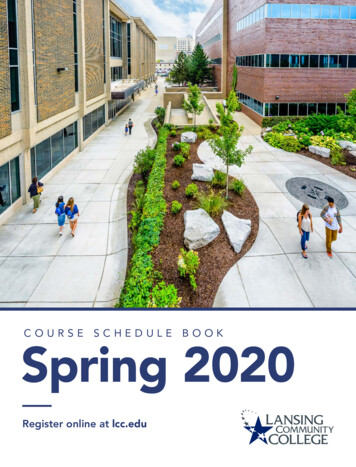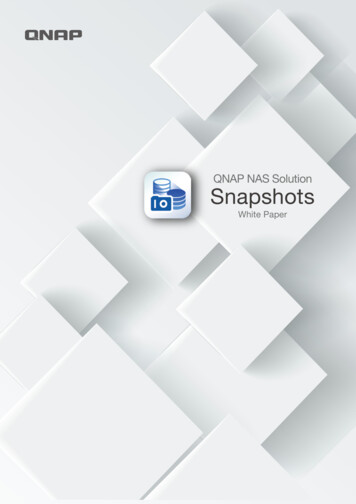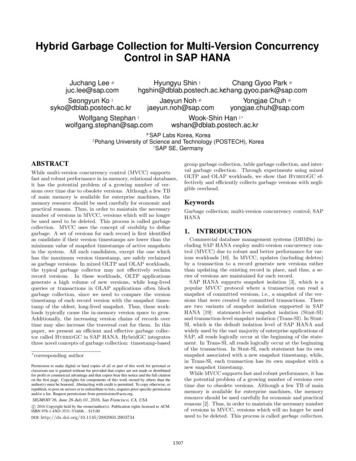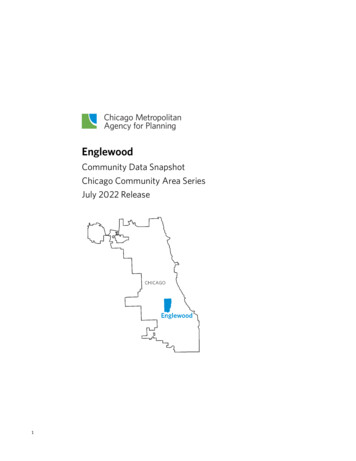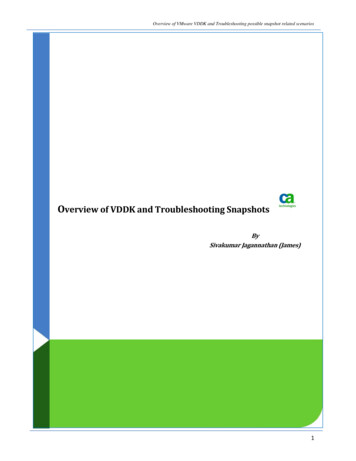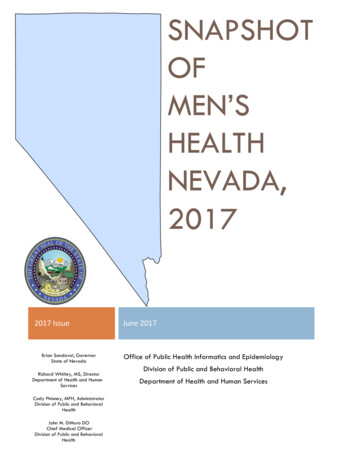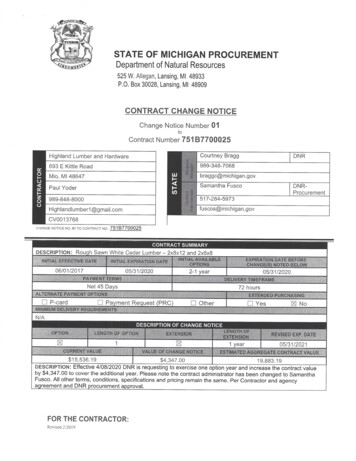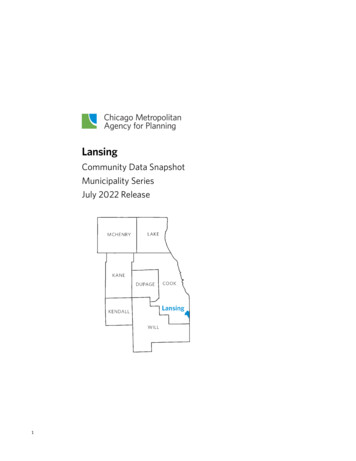
Transcription
LansingCommunity Data SnapshotMunicipality SeriesJuly 2022 Release1
Community Data Snapshot LansingAbout the Community Data SnapshotsThe Community Data Snapshots is a series of data profiles for every county, municipality, and Chicago Community Area (CCA)within the Chicago Metropolitan Agency for Planning (CMAP) seven-county northeastern Illinois region. The snapshots primarilyfeature data from the American Community Survey (ACS) five-year estimates, although other data sources include the U.S.Census Bureau, Illinois Environmental Protection Agency (IEPA), Illinois Department of Employment Security (IDES), IllinoisDepartment of Revenue (IDR), HERE Technologies, and CMAP itself.CMAP publishes updated Community Data Snapshots annually to reflect the most recent data available. The latest version canalways be found at cmap.illinois.gov/data/community-snapshots. The underlying data can be downloaded from the CMAP DataHub. Please direct any inquiries to info@cmap.illinois.gov.To improve the Community Data Snapshots in the future, CMAP wants to hear from you! Please take a quick survey to describehow you use this data and what you would like to see in next year’s snapshots.User NotesDefinitionsFor data derived from the ACS, the Community Data Snapshots uses terminology based on the ACS subject definitions.Margins of ErrorThe ACS is a sample-based data product. Exercise caution when using data from low-population communities, as the margins oferror are often large compared to the estimates. For more details, please refer to the ACS sample size and data qualitymethodology.Regional ValuesRegional values are estimated by aggregating ACS data for the seven counties that compose the CMAP region. These countiesare Cook, DuPage, Kane, Kendall, Lake, McHenry, and Will.Median ValuesThe Census Bureau encourages users to aggregate small levels of geographies into larger areas to estimate median values forthose areas. Median values for the aggregated geographies (CCAs and the CMAP region) are estimated from the groupedfrequency distributions reported in the ACS.Municipalities Located in Multiple CountiesCounty data is presented for the CMAP county containing the largest portion of the municipality's population, as of the 2020decennial census.Municipalities That Extend Beyond the CMAP RegionValues derived from CMAP analyses are generally restricted to geographies that fall within the CMAP regional boundaries.Specifically, values in the General Land Use, Equalized Assessed Value, Park Access, Transit Availability, Walkability, WaterSupply, and ON TO 2050 Indicators tables only represent the portion of each municipality that falls within the seven-countyCMAP region. This snapshot is for Lansing, which does not extend beyond the CMAP region.2
Community Data Snapshot LansingPopulation and HouseholdsThe population and household tables include general demographic, social, and economic characteristics summarized for Lansing.General Population Characteristics, 2020LansingCook CountyCMAP tCook CountyCountPercentCMAP RegionCountPercentTotal PopulationTotal HouseholdsAverage Household SizePercent Population Change, 2010-20Percent Population Change, 2000-20Source: 2000, 2010 and 2020 Census.Race and Ethnicity, 2016-2020White (Non-Hispanic)Hispanic or Latino (of Any Race)Black (Non-Hispanic)Asian (Non-Hispanic)Other/Multiple Races 025.322.97.42.4Source: 2016-2020 American Community Survey five-year 350.623.116.57.32.5Universe: Total populationAge Cohorts, 2016-2020LansingCountPercentUnder 55 to 1920 to 3435 to 4950 to 6465 to 7475 to 8485 and OverMedian e: 2016-2020 American Community Survey five-year estimates.34.222.316.920.419.19.54.53.2Cook 58.44.22.0CMAP 019.28.44.11.9Universe: Total population
Community Data Snapshot LansingEducational Attainment*, 2016-2020LansingCountPercentLess than High School DiplomaHigh School Diploma or EquivalentSome College, No DegreeAssociate’s DegreeBachelor’s DegreeGraduate or Professional 17.68.7Cook 361587,058CMAP RegionCountPercent12.322.618.46.623.616.4Source: 2016-2020 American Community Survey five-year estimates.*Highest degree or level of school completed by an 95934,42311.022.418.97.124.516.2Universe: Population 25 years and olderNativity, 2016-2020NativeForeign BornCountLansingPercent24,8022,81289.810.2Cook : 2016-2020 American Community Survey five-year estimates.CMAP se: Total populationLanguage Spoken at Home and Ability to Speak English, 2016-2020LansingCount PercentEnglish OnlySpanishSlavic LanguagesChineseTagalogArabicKoreanOther Asian LanguagesOther Indo-European LanguagesOther/Unspecified LanguagesTOTAL NON-ENGLISHSpeak English Less than “Very 12.80.80.00.20.20.01.91.80.318.07.7Cook Source: 2016-2020 American Community Survey five-year estimates.*For people who speak a language other than English at home, the ACS asks whether they speak English“very well,” “well,” “not well,” or “not at AP e: Population 5 years and older
Community Data Snapshot LansingHousehold Size, 2016-2020LansingCountPercent1-Person Household2-Person Household3-Person Household4-or-More-Person Household3,4163,3231,6102,39231.830.915.022.3Cook 30.214.821.8Source: 2016-2020 American Community Survey five-year estimates.CMAP 30.915.624.3Universe: Occupied housing unitsHousehold Type, 2016-2020LansingCount PercentFamilySingle Parent with ChildNon-Family6,8181,7353,92363.516.236.5Cook .6Source: 2016-2020 American Community Survey five-year estimates.CMAP 35.7Universe: Occupied housing unitsHousehold Income, 2016-2020LansingCount PercentLess than 25,000 25,000 to 49,999 50,000 to 74,999 75,000 to 99,999 100,000 to 149,999 150,000 and OverMedian IncomePer Capita Income*2,0842,4662,3171,3681,638868 57,659 28,70819.423.021.612.715.28.1Cook 926357,178 67,886 39,23919.218.815.912.315.917.9Source: 2016-2020 American Community Survey five-year estimates.CMAP 161644,573 76,606 40,60116.117.415.712.717.620.4Universe: Occupied housing units*Universe: Total populationHousehold Computer and Internet Access, 2016-2020LansingCount PercentOne or More Computing DevicesSmartphone(s) OnlyNo Computing DevicesInternet AccessBroadband SubscriptionNo Internet Access9,9611,2637809,6159,2641,126Source: 2016-2020 American Community Survey five-year estimates.592.711.87.389.586.210.5Cook CountyCount 1,54091.48.48.687.984.812.1CMAP RegionCount 0,53892.77.27.389.887.210.2Universe: Occupied housing units
Community Data Snapshot LansingHousing Occupancy and Tenure, 2016-2020LansingCount PercentOccupied Housing UnitsOwner-Occupied*Renter-Occupied*Vacant Housing Units10,7417,1433,59892792.166.533.57.9Cook CountyCount 89.4Source: 2016-2020 American Community Survey five-year estimates.CMAP RegionCount 5.87.8Universe: Housing units*Universe: Occupied housing unitsHousing Costs as a Percentage of Household Income*, 2016-2020LansingCount PercentLess than 20,000Less than 20 Percent20 to 29 Percent30 Percent or More 20,000 to 49,999Less than 20 Percent20 to 29 Percent30 Percent or More 50,000 to 74,999Less than 20 Percent20 to 29 Percent30 Percent or More 75,000 or MoreLess than 20 Percent20 to 29 Percent30 Percent or .56.237.130.16.01.0Cook 916.25.15.85.347.232.011.53.7Source: 2016-2020 American Community Survey five-year estimates.*Excludes households with zero/negative income, and renting households paying no cash rent.CMAP 4.514.516.04.95.75.451.935.012.84.2Universe: Occupied housing unitsHousing & Transportation (H T) Costs as a Percentage of Household Income*, 2012-2016Housing CostsTransportation CostsTOTAL H T COSTSMedian-Income Family**Moderate-Income Family***252247322355Source: U.S. Department of Housing and Urban Development, Location Affordability Index (2012-2016).*The purpose of the H T Index is to isolate the effect of location on housing and transportation costs, and is reported for different household typologies. Thevalues above represent the percent of household income that an average household of each type spends on housing and transportation. The standard thresholdof affordability is 30% for housing costs alone, and 45% for housing and transportation costs combined.**“Median-income family” assumes a 4-person, 2-commuter household with income equal to the regional median.***“Moderate-income family” assumes a 3-person, 1-commuter household with income equal to 80% of the regional median.6
Community Data Snapshot LansingHousing CharacteristicsThe housing characteristics tables include housing unit estimates by housing type, size, and age summarized for Lansing.Housing Type, 2016-2020Single Family, DetachedSingle Family, Attached2 Units3 or 4 Units5 to 9 Units10 to 19 Units20 or More UnitsMobile 973510870.01.90.45.28.66.86.30.9Cook Source: 2016-2020 American Community Survey five-year estimates.*“Other” includes boats, recreational vehicles (RVs), vans, etc.CMAP 8Universe: Housing unitsHousing Size, 2016-2020Count0 or 1 Bedroom2 Bedrooms3 Bedrooms4 Bedrooms5 or More BedroomsMedian Number of 9.740.618.02.0Cook 555.220.131.131.912.54.3Source: 2016-2020 American Community Survey five-year estimates.*Includes living rooms, dining rooms, kitchens, bedrooms, etc., that are separated by built-in, floor-to-ceiling walls.Excludes bathrooms, porches, balconies, foyers, halls, and unfinished basements.CMAP 2,1576.016.128.033.317.65.0Universe: Housing unitsHousing Age, 2016-2020CountBuilt 2000 or LaterBuilt 1970 to 1999Built 1940 to 1969Built Before 1940Median Year BuiltLansingPercent5654,5835,2761,2441967Source: 2016-2020 American Community Survey five-year estimates.74.839.345.210.7Cook 10.026.335.428.3CMAP 196914.034.430.521.1Universe: Housing units
Community Data Snapshot LansingTransportationThe transportation tables include vehicle availability by household, mode of travel to work, annual vehicle miles traveled, andtransit availability for Lansing.Vehicles Available per Household, 2016-2020LansingCountPercentNo Vehicle Available1 Vehicle Available2 Vehicles Available3 or More Vehicles Available5594,6413,6381,9035.243.233.917.7Cook 40.329.812.3Source: 2016-2020 American Community Survey five-year estimates.CMAP 12.735.435.016.9Universe: Occupied housing unitsMode of Travel to Work, 2016-2020CountWork at Home*Drive AloneCarpoolTransitWalk or BikeOtherTOTAL COMMUTERSMean Commute Time 1.85.280.16.25.91.61.094.8Cook urce: 2016-2020 American Community Survey five-year estimates.*Not included in total commuters or mean commute time.CMAP iverse: Workers 16 years and olderAnnual Vehicle Miles Traveled per Household*, 2017Average Vehicle Miles Traveled per YearLansingCook CountyCMAP Region19,83614,12317,165Source: Chicago Metropolitan Agency for Planning analysis of 2017 Illinois Environmental Protection Agency, HERE Technologies, and U.S. Census Bureaudata.*Data not available for all communities in the CMAP region.Transit Availability of Resident and Job Locations*, 2017High Transit AvailabilityModerate Transit AvailabilityLow Transit AvailabilityLansingCook CountyCMAP ource: Chicago Metropolitan Agency for Planning analysis of the 2017 Transit Availability Index.*The CMAP Transit Availability Index is based on four factors: frequency of transit service, proximity to transit stops, activities reachable without a transfer, andpedestrian friendliness. This table reports the share of residents plus jobs whose home and workplace locations, respectively, are within each Transit AvailabilityIndex category.8
Community Data Snapshot LansingEmploymentThe employment tables include general workforce characteristics for Lansing.Employment Status, 2016-2020LansingCount Percent14,13012,3641,7408,154In Labor ForceEmployed†*Unemployed*Not in Labor Force63.487.512.336.6Cook CountyCount Percent2,756,3482,560,882193,9521,410,947CMAP RegionCount Percent66.192.97.033.9Source: 2016-2020 American Community Survey five-year estimates.†Does not include employed population in the Armed .232.7Universe: Population 16 years and older*Universe: In labor forcePrivate Sector Employment*, 2021LansingCount Percent6,242-3,093-6,8250.58Private Sector EmploymentJob Change, 2011-21Job Change, 2001-21Private Sector Jobs per Household***N/A-33.1-52.2Cook 5-10.16-County A4.7-4.2Source: Illinois Department of Employment Security, Where Workers Work report (2021).*Figures exclude employees not covered by unemployment insurance. Data not available for all communities in the CMAP region.**Data is not available for Kendall County.***Based on households from 2016-2020 American Community Survey five-year estimates.Employment of Lansing Residents*, 2019TOP INDUSTRY SECTORS1. Health Care2. Retail Trade3. Manufacturing4. Education5. Accommodation and FoodServiceTOP EMPLOYMENT LOCATIONS1. Chicago2. Lansing3. South Holland4. Calumet City5. HarveyEmployment in Lansing*, 9.18.72,8821,02831423719725.49.12.82.11.7TOP INDUSTRY SECTORS1. Retail Trade2. Manufacturing3. Accommodation and FoodService4. Education5. Health CareTOP RESIDENCE LOCATIONS1. Chicago2. Lansing3. Calumet City4. Lynwood5. South HollandSource: U.S. Census Bureau, Longitudinal Employer-Household Dynamics program (2019).*Excludes residents working outside of, and workers living outside of, the seven-county CMAP 44811.05.81,1831,02828013312615.413.43.71.71.6
Community Data Snapshot LansingLand UseThe land use tables include general land use composition, park access, and walkability for Lansing.General Land Use, 2015Single-Family ResidentialMulti-Family ResidentialCommercialIndustrialInstitutionalMixed UseTransportation and OtherAgriculturalOpen 16.10.331.04.74.34.3100.0Source: Chicago Metropolitan Agency for Planning analysis of the 2015 Land Use Inventory.Park Access, 2015Accessible Park Acreage per 1,000Residents*LansingCook CountyCMAP Region4.353.575.78Source: Chicago Metropolitan Agency for Planning analysis of the 2015 Park Access Layer.*Neighborhood parks (smaller than 35 acres) are considered accessible for residents living within 0.5 miles; community parks (35 acres or larger) areconsidered accessible for residents living within 1 mile.Walkability of Resident and Job Locations*, 2018High WalkabilityModerate WalkabilityLow WalkabilityLansingCook CountyCMAP %Source: Chicago Metropolitan Agency for Planning analysis of the 2018 Walkability Layer.*The CMAP Walkability Layer is based on several factors: the presence/absence of sidewalks; the number of amenities within walking distance;population/employment density; bicycle/pedestrian crashes and fatalities; and physical characteristics (e.g., tree cover, block length). This table reports theshare of residents plus jobs whose home and workplace locations, respectively, are within each Walkability Layer category.10
Community Data Snapshot LansingTax BaseThe tax base tables include retail sales and equalized assessed values for Lansing.General Merchandise Retail Sales, 2021General MerchandiseTotal Retail SalesTotal Sales per Capita*LansingCook CountyCMAP Region 362,397,524 429,432,883 15,551 48,756,704,152 66,205,004,950 12,807 93,569,186,184 122,031,374,715 14,439Source: Illinois Department of Revenue, 2021.*Per capita calculations based on population from 2016-2020 American Community Survey five-year estimates.Equalized Assessed Value, eralTOTALSources: Illinois Department of Revenue, 2020.11 262,783,221 117,481,896 34,103,080 265,704 63,070 0 414,696,971
Community Data Snapshot Lansing Time SeriesChange Over TimeThe time series tables include comparisons of current 2016-2020 ACS estimates to historic year estimates from the 2000Census and 2006-2010 ACS.Race and Ethnicity, Over TimeWhite (Non-Hispanic)Hispanic or Latino (of Any Race)Black (Non-Hispanic)Asian (Non-Hispanic)Other/Multiple Races 42.92.94.4Source: 2000 Census; 2006-2010 and 2016-2020 American Community Survey five-year estimates.Universe: Total populationAge Cohorts, Over Time19 and Under20 to 3435 to 4950 to 6465 and OverMedian .920.419.117.240.2Source: 2000 Census; 2006-2010 and 2016-2020 American Community Survey five-year estimates.Universe: Total populationEducational Attainment*, Over TimeLess than High School DiplomaHigh School Diploma or EquivalentSome College, No DegreeAssociate’s DegreeBachelor’s DegreeGraduate or Professional 24.28.417.68.7Source: 2000 Census; 2006-2010 and 2016-2020 American Community Survey five-year estimates.*Highest degree or level of school completed by an individual.12Universe: Population 25 years and older
Community Data Snapshot Lansing Time SeriesNativity, Over TimeNativeForeign .2Source: 2006-2010 and 2016-2020 American Community Survey five-year estimates.Universe: Total population*Universe: Population 5 years and olderLanguage Spoken at Home and Ability to Speak English, Over TimeEnglish OnlySpanishSlavic LanguagesChineseTagalogArabicKoreanOther Asian LanguagesOther Indo-European LanguagesOther/Unspecified LanguagesTOTAL NON-ENGLISHSpeak English Less than “Very 01.91.80.318.07.7Source: 2006-2010 and 2016-2020 American Community Survey five-year estimates.*For people who speak a language other than English at home, the ACS asks whether they speak English“very well,” “well,” “not well,” or “not at all.”13Universe: Population 5 years and older
Community Data Snapshot Lansing Time SeriesHousehold Size, Over Time1-Person Household2-Person Household3-Person Household4-or-More-Person 4.521.931.830.915.022.3Source: 2006-2010 and 2016-2020 American Community Survey five-year estimates.Universe: Occupied housing unitsHousehold Type, Over TimeFamilySingle Parent with 310.237.763.516.236.5Source: 2006-2010 and 2016-2020 American Community Survey five-year estimates.Universe: Occupied housing unitsHousehold Income, Over Time2006-2010(2020 Dollars)2016-2020(2020 Dollars) 60,013Median Income 57,659Source: 2006-2010 and 2016-2020 American Community Survey five-year estimates.Universe: Occupied housing unitsHousing Occupancy and Tenure, Over TimeOccupied Housing UnitsOwner-Occupied*Renter-Occupied*Vacant Housing .275.324.72.893.773.326.76.392.166.533.57.9Source: 2000 Census; 2006-2010 and 2016-2020 American Community Survey five-year estimates.14Universe: Housing units*Universe: Occupied housing units
Community Data Snapshot Lansing Time SeriesHousing Costs as a Percentage of Household Income*, Over 811.128.64.67.316.722.28.57.56.237.130.16.01.0Less than 20,000Less than 20 Percent20 to 29 Percent30 Percent or More 20,000 to 49,999Less than 20 Percent20 to 29 Percent30 Percent or More 50,000 to 74,999Less than 20 Percent20 to 29 Percent30 Percent or More 75,000 or MoreLess than 20 Percent20 to 29 Percent30 Percent or MoreSource: 2006-2010 and 2016-2020 American Community Survey five-year estimates.*Excludes households with zero/negative income, and renting households paying no cash rent.15Universe: Occupied housing units
Community Data Snapshot Lansing Time SeriesHousing Type, Over TimeSingle Family, DetachedSingle Family, Attached2 Units3 or 4 Units5 or More UnitsMobile 1.15.224.40.070.01.90.45.221.70.9Source: 2006-2010 and 2016-2020 American Community Survey five-year estimates.*“Other” includes boats, recreational vehicles (RVs), vans, etc.Universe: Housing unitsHousing Size, Over Time0 or 1 Bedroom2 Bedrooms3 Bedrooms4 Bedrooms5 or More BedroomsMedian Number of 16.41.45.59.729.740.618.02.05.8Source: 2006-2010 and 2016-2020 American Community Survey five-year estimates.*Includes living rooms, dining rooms, kitchens, bedrooms, etc., that are separated by built-in, floor-to-ceiling walls.Excludes bathrooms, porches, balconies, foyers, halls, and unfinished basements.Universe: Housing unitsHousing Age, Over TimeBuilt 2000 or LaterBuilt 1970 to 1999Built 1940 to 1969Built Before 1940Median Year BuiltSource: 2006-2010 and 2016-2020 American Community Survey five-year 451.38.019654.839.345.210.71967Universe: Housing units
Community Data Snapshot Lansing Time SeriesVehicles Available per Household, Over TimeNo Vehicle Available1 Vehicle Available2 Vehicles Available3 or More Vehicles .515.95.243.233.917.7Source: 2006-2010 and 2016-2020 American Community Survey five-year estimates.Universe: Occupied housing unitsMode of Travel to Work, Over TimeWork at Home*Drive AloneCarpoolTransitWalk or BikeOtherTOTAL COMMUTERSMean Commute Time e: 2006-2010 and 2016-2020 American Community Survey five-year estimates.*Not included in total commuters or mean commute time.Universe: Workers 16 years and olderEmployment Status, Over TimeIn Labor ForceEmployed†*Unemployed*Not in Labor ForceSource: 2006-2010 and 2016-2020 American Community Survey five-year estimates.†Does not include employed population in the Armed .033.663.487.512.336.6Universe: Population 16 years and older*Universe: In labor force
Community Data Snapshot Lansing Water SupplyWater SupplyCMAP supports an integrated approach to water resource management, and encourages communities to incorporate watersupply and demand considerations into land use, transportation, and infrastructure investment decisions. Assessing demand,price, and loss trends of a community can inform decisions that strengthen regional water supply management, maintain drinkingwater infrastructure, and manage demand. CMAP’s ON TO 2050 plan contains more information about how communities cancoordinate and conserve our shared water supply resources.Water Source and Demand Trends of Lansing*Primary Water Source: Lake Michigan**2003 MGD***2013 MGD***Percent Change3.612.011.603.412.331.08-5.716.1-32.9Total Water Withdrawals****Residential SectorNon-Residential SectorSource: Analysis of Illinois Water Inventory Program water withdrawal data (2003-2013).*Only available for municipalities with community water suppliers providing service to the majority of the community.**The primary water source of a community is based on the source of the majority of withdrawals from all wells and intakes within the community, includingcommunity water suppliers and industrial and commercial businesses. The majority of withdrawals is calculated as an average from yearly data, given year toyear fluctuations.***Millions of gallons per day.****Total includes all community water suppliers and industrial and commercial wells/intakes within a municipality; private residential wells are not included.Residential sector includes withdrawals identified as residential by community water suppliers. Non-residential sector includes withdrawals identified as nonresidential by the community water suppliers and withdrawals from industrial and commercial wells/intakes.Daily Residential Water Demand per CapitaResidential* (GPCD**)20032013LansingPercent Change20032013CMAP RegionPercent Change71.381.714.5104.287.5-16.0Source: Analysis of Illinois Water Inventory Program water withdrawal data (2003-2013).*Residential sector includes withdrawals identified as residential by community water suppliers. The prevalence of private residential wells or community watersuppliers that provide water outside of the municipal boundary could lead to artificially lower or higher GPCD values respectively.**Gallons of water per capita per day (estimated unit use). Population values used in sector totals come from the U.S. Census.Residential Water and Wastewater Price Trends*MONTHLY COST PER 5,000 GALLONS**Drinking WaterSewerCombined***2014(2021 Dollars)2020(2021 Dollars)PercentChangeAnnualizedPercent Change 29.76 4.64N/A 29.16 4.97N/A-2.07.3N/A-0.31.2N/ASource: Illinois-Indiana Sea Grant Water Rates Data for Northeastern Illinois, IISG19-RCE-RLA-031.*Only available for communities with water utilities and that responded to data requests. Percent changes and prices were adjusted for inflation using the U.S.Bureau of Labor Statistics’ Consumer Price Index for All Urban Consumers (CPI-U).**Monthly water bills are calculated as: monthly base charge ((5,000 gallons water provision included in base charge) /1,000 gallons). Note that actual billingcalculation practices may vary across communities.***Some utilities combine drinking water and sewer prices, rather than separating them as two distinct rates.18
Community Data Snapshot Lansing Water SupplyWater Loss*Reporting utility: Lansing2017Nonrevenue Water (Millions of Gallons perDay)**Annual Cost of Nonrevenue WaterPercent of Nonrevenue Water to WaterSupplied***0.57 712,92919.6Source: Illinois Department of Natural Resources, Lake Michigan Allocation Program, 2017.*Data is only regionally available for Lake Michigan permittees; water losses from other communities and industrial and commercial businesses are not reportedto the state.**Nonrevenue water is the difference between net annual pumpage (water supplied) and billed, authorized consumption. Non-revenue water includes water thatis lost from the system due to underregistration of meters, systematic data handling errors, leakage anywhere within the distribution system, unauthorizedconsumption, or unbilled authorized consumption.***The threshold for permit compliance is less than 12% of water supplied in Water Year 2015, decreasing to no more than 10% by Water Year 2019 and all yearsthereafter. Permittees that exceed the threshold are required to submit a water system improvement plan.19
Community Data Snapshot Lansing ON TO 2050ON TO 2050 IndicatorsON TO 2050 is the region’s long-range comprehensive plan, adopted by CMAP in 2018. The plan includes a set of indicators forquantifying its goals and measuring implementation progress. While many of these indicators can only be measured at aregional level, several can also be tracked at a local level. These have been laid out in the table below, with comparisons to theregion’s current measure as well as the targets th
Lansing Cook County CMAP Region Count Percent Count Percent Count Percent White (Non-Hispanic) Hispanic or Latino (of Any Race) Black (Non-Hispanic) Asian (Non-Hispanic) Other/Multiple Races (Non-Hispanic) Source: 2016-2020 American Community Survey five-year estimates. Universe: Total population Age Cohorts, 2016-2020 Lansing Cook County CMAP .

